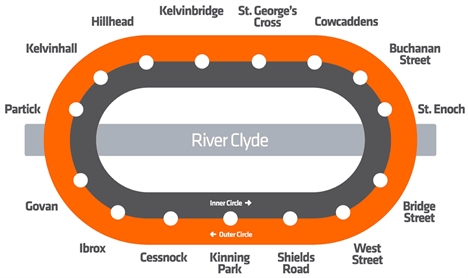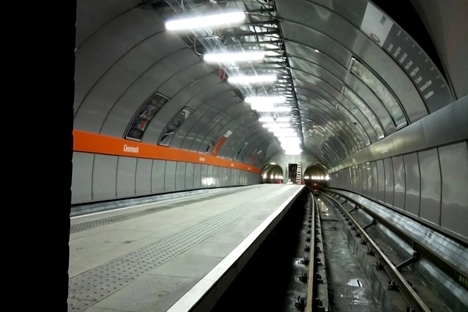11.05.17
Glasgow: subway station upgrades reach halfway point
Source: RTM Apr/May 17
Charles Hoskins, senior director at the Strathclyde Partnership for Transport (SPT), gives RTM an update on the £300m Glasgow Subway Modernisation programme and the work still to do.
At the end of 2016, Glasgow Subway celebrated its 120th birthday. And now the major station upgrade of the third oldest underground system in the world, behind London and Budapest, has reached its halfway point – with eight of its 15 stations now complete.
As well as celebrating a major anniversary, last year was a significant period for the project with SPT awarding Stadler Bussnang AG/Ansaldo STS Consortium the £200m contract to supply the network’s new trains, signalling and equipment in March. The project team also completed modernisation works at Buchanan Street and Cessnock stations.
Discussing the upgrade work, Charles Hoskins, senior director at SPT, which is responsible for the delivery of the multi-million pound investment project, said he was delighted to have reached this milestone.
“The stations we have completed are the main ones in the city centre, including a big interchange station at Govan, which was for subway, bus and Fastlink,” he said.
Cessnock and its complexity
Asked which station has been the most rewarding, Hoskins told us it would be easy to say one of the high-profile ones such as Govan and St. Enoch. The latter even won the Excellence Public Realm award at the Scottish Transport Awards for the redevelopment work, which has transformed St. Enoch Square with new glass canopies at the north and south entrances.
“But the one that gave us most pleasure was Cessnock,” he said. “Cessnock station is relatively small in physical size, and its main concourse area, which is really small, is actually within a residential tenement. To give you an example of the complexity of the work, when we stripped the ceiling from the concourse area, we could see the floorboards of the apartment above!
“What that meant was a very detailed consultation exercise before, during and, indeed, after the works. I have to say, our team and, most importantly, the contractor, who in this case was GRAHAM Construction, did an amazing job.
“What we had to do was to look at the noise activities we could do during the day, which is difficult because we have staff and customers, but at night time we had residents who were trying to sleep in the apartments above. It was an extremely difficult and tricky station, and we were pleased to have completed that programme just before Christmas last year.”
In July 2016, Glasgow Subway services were also suspended to provide engineers with access to the network’s tunnels. However, the renewal works that took place in its ‘ramps and turnouts’ section was delayed. This was because it took the contractor longer than expected to replace concrete in the tunnels, and work was delayed by heavy rain. But, despite these challenges, Hoskins has been pleased with the progress.

Water ingress challenges
Back in September, modernisation works also began at Kelvinbridge station and the project team were still on site at the time of our interview.
“We are currently on-site with Kelvinbridge station and about to tender for Bridge Street and Shields Road,” said Hoskins. “After we have completed Kelvinbridge we will have six stations to complete. We will have, after Bridge Street and Shields Road, which we are looking to do this financial year, West Street, Kinning Park, Cowcaddens and St. George’s Cross.”
Asked about the difficulty experienced in upgrading the stations, which last had a revamp in the 1970s, Hoskins stated that major water ingress problems have been an issue at Kelvinbridge – and it will be an obstacle to overcome at St. George’s Cross.
“Those two stations in particular have major water ingress problems,” he said. “The geology of the surrounding land, along with the fact that the station fabric has got to the stage where some of the joints in the concrete in the fabric of the building have broken down to the stage where they have needed significant investment, have caused problems.
“What we did in Kelvinbridge was an advanced water sealing contract, we had to do that some time ago, and we monitored that over six to nine months to make sure there was no further water ingress. Then we did the station refurbishment.
“From a cost and certainty perspective, that has been really good. However, the disadvantage is that clearly the customers see, potentially, a station being refurbished for a lot longer than otherwise we would take. That has been a really difficult balance for us: to make sure we are still presenting the station as best we can, while recognising it will take longer as we have to do advanced works.”
Now they have the same issue at St. George’s Cross, noted Hoskins, and a lot of these issues are hidden. For example, at platform level the panelling tends to hide the water ingress issues.
“We have a lot of subway work to do at night to investigate all of these areas, and it is like any challenge for this kind of age of infrastructure: you never solve it, you just keep it at bay for a little longer,” he said. “We are just about to finish the exercise and the water sealing investigation feasibility work. It is a similar issue to Kelvinbridge, but the engineering is different.”

Improving accessibility
A further issue that SPT has experienced during the programme has been that of improving accessibility and lift access at stations.
Lifts have only been installed at two stations: St. Enoch and Govan. But these are the first of their kind in the network, and Otis has now replaced all 28 escalators throughout the system.
“Our subway is really small, and the station platforms are extremely tight, so it is impossible to provide lift access at all the stations,” argued Hoskins. “We spent the best part of two years looking at how we can improve accessibility, but installing lifts at all 15 stations would have meant rebuilding the entire system.
“When we looked at that, it was the best part of three years of a closure: rebuilding 15 stations and that would probably have taken up all the cost for modernisation. There has been a very tricky balance we have had to reach.”
Another way the project team has attempted to improve accessibility is that all station stairways now have 30-point colour contrast stair nosings to assist passengers with visual impairment. There are also corduroy tactile strips at the top and bottom of each staircase to assist visually-impaired passengers locate stairs, and tactile maps have been put in place at key stations.
“A lot of people, when they talk about accessibility, have in their minds that you have to put a lift in when, actually, there are all sorts of equalities improvements we can make to the stations – even simple things such as lighting, map information and website information provided,” said Hoskins. “We have done a lot of work with the RNIB, Access Scotland and all the various stakeholders.
“People come into the subway because they want to get somewhere relatively quickly and really reliably. Our job is to make that as seamless as possible, so if it is well-lit, clean and inviting, you feel safe and secure when making your journey. If we can incorporate some local public art, or small retail units, we look at that for every station – each one is different, so there is an individuality to each of them.”
As well as introducing new trains and modernising the station environment, there is also a lot of work ongoing with regards to smart ticketing. While it is still some time until the modernisation programme is complete and new trains start being seen on the network from 2020, Hoskins is confident that SPT is creating an “an environment people want to come into and travel through”.
© BertieB